Meta-parametrised meta-modelling approach for optimal design of power electronics conversion systems: Application to offshore wind energy
Doctoral thesis

Åpne
Permanent lenke
http://hdl.handle.net/11250/284870Utgivelsesdato
2015Metadata
Vis full innførselSamlinger
- Institutt for elkraftteknikk [2465]
Sammendrag
In an offshore environment, the efficiency (η), the power density (ρ) and the powerto-
mass ratio (γ) are of paramount importance in the design of wind energy conversion
systems (WECS). Indeed, the optimisation of these performance indices can
reduce investment costs, especially if most of the electrical conversion components
are located in the nacelle or tower of the wind turbine. This thesis describes a
simple procedure to calculate the η, the ρ and the γ of power converters via the calculation
of power losses, volume and mass of the main components of the WECS:
the power electronics valves, the magnetic components and the capacitors.
In the proposed method, the system is first characterised, then a set of figures
of merits are evaluated for a set of design parameters. Finally, a multi-objective
optimisation is performed and the Pareto concept is used to present the set of solutions
(for different sets of parameters) and the best trade-off for the performance
indicators is identified. The approach does not identify a unique solution; instead,
several solutions are obtained and other criteria can be used to choose the final
solution, thus giving freedom in the design process and flexibility in the final decisions
of conceptual design.
The proposed method is applied to different offshore WECS topologies to illustrate
the evaluation procedure. First, a well known topology used in AC-Grid connected
wind turbines, the two level voltage source converter, is considered. Then, the
meta-parametrised approach and the fundamental component models described in
this thesis are used to compare six different WECS based on a medium frequency
transformer for a 10MW WECS interfacing a permanent magnet synchronous generator
suitable for offshore DC-grids. A modular approach in the power converter
is considered and the impact of the number of modules and variation in nominal
transformer frequency on performance indicators is studied.
The proposed approach can be applied to identify key components/parameters to
optimise a standard solution, to quantify the impact of a new component technology
on state-of-the-art solutions for a given application, or to determine, at least
in part, the best solutions for new applications regarding state-of-the-art converter
topologies, modulation strategies, component technologies and system parameters.